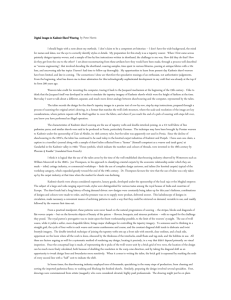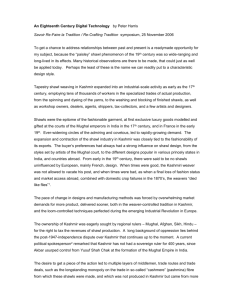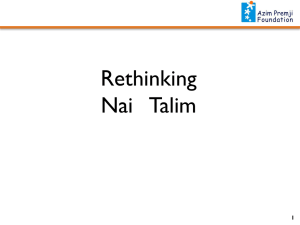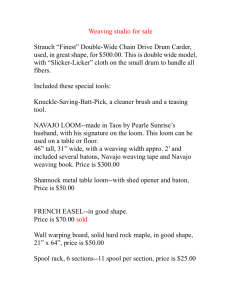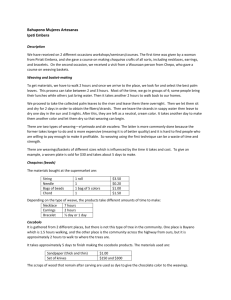Revisiting Kashmir in Spirit - peter harris, tapestryweaver
advertisement
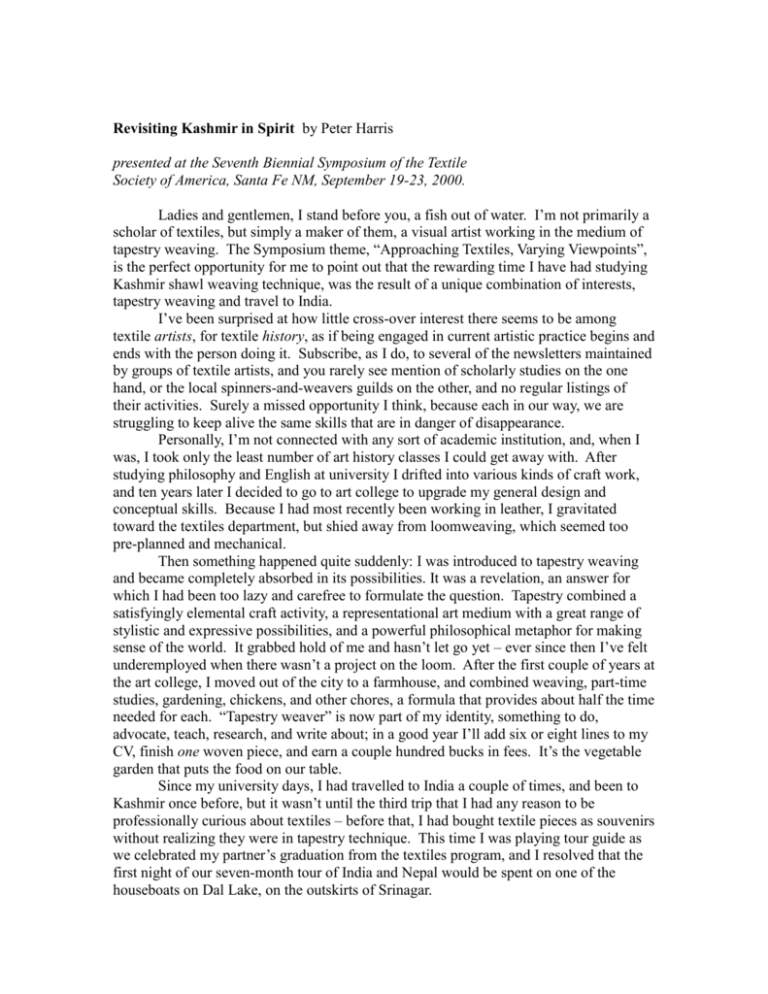
Revisiting Kashmir in Spirit by Peter Harris presented at the Seventh Biennial Symposium of the Textile Society of America, Santa Fe NM, September 19-23, 2000. Ladies and gentlemen, I stand before you, a fish out of water. I’m not primarily a scholar of textiles, but simply a maker of them, a visual artist working in the medium of tapestry weaving. The Symposium theme, “Approaching Textiles, Varying Viewpoints”, is the perfect opportunity for me to point out that the rewarding time I have had studying Kashmir shawl weaving technique, was the result of a unique combination of interests, tapestry weaving and travel to India. I’ve been surprised at how little cross-over interest there seems to be among textile artists, for textile history, as if being engaged in current artistic practice begins and ends with the person doing it. Subscribe, as I do, to several of the newsletters maintained by groups of textile artists, and you rarely see mention of scholarly studies on the one hand, or the local spinners-and-weavers guilds on the other, and no regular listings of their activities. Surely a missed opportunity I think, because each in our way, we are struggling to keep alive the same skills that are in danger of disappearance. Personally, I’m not connected with any sort of academic institution, and, when I was, I took only the least number of art history classes I could get away with. After studying philosophy and English at university I drifted into various kinds of craft work, and ten years later I decided to go to art college to upgrade my general design and conceptual skills. Because I had most recently been working in leather, I gravitated toward the textiles department, but shied away from loomweaving, which seemed too pre-planned and mechanical. Then something happened quite suddenly: I was introduced to tapestry weaving and became completely absorbed in its possibilities. It was a revelation, an answer for which I had been too lazy and carefree to formulate the question. Tapestry combined a satisfyingly elemental craft activity, a representational art medium with a great range of stylistic and expressive possibilities, and a powerful philosophical metaphor for making sense of the world. It grabbed hold of me and hasn’t let go yet – ever since then I’ve felt underemployed when there wasn’t a project on the loom. After the first couple of years at the art college, I moved out of the city to a farmhouse, and combined weaving, part-time studies, gardening, chickens, and other chores, a formula that provides about half the time needed for each. “Tapestry weaver” is now part of my identity, something to do, advocate, teach, research, and write about; in a good year I’ll add six or eight lines to my CV, finish one woven piece, and earn a couple hundred bucks in fees. It’s the vegetable garden that puts the food on our table. Since my university days, I had travelled to India a couple of times, and been to Kashmir once before, but it wasn’t until the third trip that I had any reason to be professionally curious about textiles – before that, I had bought textile pieces as souvenirs without realizing they were in tapestry technique. This time I was playing tour guide as we celebrated my partner’s graduation from the textiles program, and I resolved that the first night of our seven-month tour of India and Nepal would be spent on one of the houseboats on Dal Lake, on the outskirts of Srinagar. 2 During a day of haphazard sightseeing in the city, we found ourselves at the School of Designs, a row of workrooms where a few artisans were demonstrating typical Kashmiri crafts, including patterned loomweaving that I recognized as a tapestry technique. In the days before and after, we were shown hundreds of shawls, by dealers who boarded our houseboat or ambushed us at every turn, but all of them were either plain fabrics or embroidered. In the following months of touring around India, we grew more skilled in our inquiries and saw many fine textile techniques in action, but no other tapestry traditions except the simple geometric patterns of Kulu shawls and flatwoven dhurry carpets. Later, during a stopover in London on our way home to Canada, I came across a reprint of The Kashmir Shawl by John Irwin in the bookshop of the Victoria and Albert Museum, and quickly realized it referred to the technique I had seen at the School of Designs, although Irwin wrote in 1955 that “the shawl industry was dead, and the art of its weavers irrecoverably lost” by the end of the 19th century.1 One of the plates in John Irwin’s book2 shows one page of talim, a version of the visual design in the form of line-by-line instructions for the weaver. Through guesswork and simple logic I was able to piece together the numerical value of the various symbols, and obtain a coherent image of the part of the design represented by that page. My initial success drew me on to consider how this short-hand record of the design is translated into weaving. The reconstruction of a carpet design, for which in Kashmir talim is also used, would seem relatively straightforward. The refinements visible in shawl fabrics – twill weave, excessively fine scale, interlocking, and continually adding and dropping different-coloured wefts – call for a tapestry weaver’s understanding. I had to wonder what the numbers referred to, and how many picks of weaving were made following each line of text. It wasn’t so easy to resolve these basic questions of procedure, that any of the weavers at the School of Designs could have answered in a moment. I inspected with a magnifier shawls in the collection of the Museum for Textiles, in Toronto. It was sobering to realize what eye-strainingly fine work was required at a typical thread count of 100 ends per inch. My own tapestry work is usually at 4 warps to the inch. I set up a small weaving sample in 2/2 twill and double-interlock, using sewing thread and individual strands of embroidery floss, for a brief, thoroughly intimidating experience of working at such fine scale. I grew convinced that the process still needs documentation to guard against “irrecoverable loss”. At the same time, I was fascinated by the broad sweep of the story of the Kashmir shawl phenomenon – the economic and technological importance, the influential patrons, the fickle imperatives of fashion. I dusted off the necessary essay-writing skills from my university days, producing the one and only long essay of my art-college career. Shortly after, it was published in Ars Textrina, in 1991. 3 This was my introduction to the hidden world of scholarship, to the backstage offices and bottom drawers of grand museums, the challenge cheerfully taken up by librarians to locate real but elusive old sources, the chivalric code of the scholarly quest. I realized there were only a few specialists with a scholarly interest in Kashmir shawls, and I was perhaps the only one with a working knowledge of tapestry weaving. Nearly every time we exchanged letters, my respondents, helpful as they were, began by saying they had no knowledge of weaving. But we did exchange letters, real ones. When I tried in vain to locate a copy of a source I first saw in his book, Frank Ames kindly told me he found it at the New York Public Library, and in due course they sent me a photocopy. Though the European travellers who witnessed the process in its heyday knew its economic importance and wrote meticulous descriptions of what they saw, none could appreciate the simplicity, necessity, and efficiency of the weaving process, so that at its heart it remained a mysterious thing that weavers do. Most secondary accounts lean heavily on the description made in 1823 by William Moorcroft, who was either a daring and inquisitive travelling businessman or a spy for the East India Company, during a six-year trek from western Tibet to Afghanistan and Central Asia. Recently reading his two-volume Travels… I learned that while moving up the Kulu Valley in the early stages of his journey, he noted “On the 11th [of August 1820] we passed a house belonging to the Raja on our right, situated on an eminence…”3 From the balcony of this royal hunting lodge, now a tourist guest house, we took photos in 1985 that resulted in this tapestry. Moorcroft’s party, on the other side of the river, moved up the valley from left to right on their way to Ladakh. G. W. Leitner was an educator and Orientalist, based in Lahore. In 1882 he published a miscellany of notes on several code languages and a collection of material about shawl talim including a four-page talim text, drawings of the design, lists of the number and colour symbols, even fabric swatches of 53 commonly-used colours.4 The talim features a consistent pattern of “half” units at the beginning and end of every second line, something not found in the Irwin talim. This one clue, correlated with the cycle of four picks in a 2/2 twill weave structure, led me to several conclusions: first,that each line of text is woven in two picks (generally supported by my examination of shawl fabrics); second, it specifies the offset relationship of the lines due to the twill displacement; and third, that the best approximation of the design on graph paper would be with a brick grid, not a square grid. These points prepared me to take a practical approach to designing and weaving a sample with the basic design and structure of the shawl technique. When my partner and I had flown in to Srinagar in 1985, Immigration checkpoints were more interested in finding out the nature of our business there, than in looking after our safety, and we were more concerned at seeing the army pickets guarding 4 the airfield during our stopover in Amritsar. At that time it was not a year since the assassination of Indira Gandhi in connection with the storming of the Golden Temple, and before a group of foreign tourists was kidnapped in the hills overlooking Srinagar. It is well known that Kashmir has been a recurrent source of conflict between India and Pakistan, since their independence fifty years ago, and in recent years has reached an entrenched, costly, and dangerous stalemate. Actually, through the centuries that it has been known for shawlweaving, Kashmir was a coveted tributary of Mughal, Afghan and Sikh regional powers, because of the revenue and prestige of its famous product. In Delhi, people who knew how interested I was in Kashmir would talk about the place only reluctantly and obliquely, as the British used to refer to the “troubles” in Northern Ireland, or as Montreal Anglophones are heartily tired of discussing Quebec sovereignty. From the archetypal spring garden of the Indian landscape, Kashmir has turned into a cultural black hole. Perhaps I’ve had an easier time of it, trying to learn shawlweaving from a handful of museum artifacts, than if I had tried to elicit the cultural birthright and commercial trade secrets of a traditional weaver. As an artist of the individualistic West, I have always felt that techniques can be shared freely because one artist’s expression will always differ from another’s. Even today, unexpectedly many Kashmiris learn to recognize talim and the shawlweaving tradition, probably through childhood experience in the knotted-carpet industry. None would see any career future in earning a living by the slow rigours of shawl weaving, in today’s world of globalization and get-rich-quick, but it is still a source of pride. I have witnessed several instances where, feeling absolutely secure in the knowledge that only fellow Kashmiris can recognize and understand the talim, mischevious weavers and sly dealers misrepresented examples of talim they were showing. In one case a page of talim was placed upside-down on the loom for the documentarian’s published photograph.5 In another more serious fraud, a collection of ten separately-named samples of talim, each with a corresponding fabric sample, was offered for sale to a museum. When I drafted the talim data I found that six of the fragments formed one continuous design, unrelated to any of the fabric samples. Meanwhile I also came across one of the same talim fragments, paired with a different fabric swatch from the collection, published under a new pattern name.6 In any discussion of the antiquarian value of a talim, the ultimate put-down is to say, “It’s only a carpet talim”, a claim that is not only about the talim, but also asserts “I know the difference and you don’t”. I confess it gives me a little thrill of private satisfaction to think, “Oh yes, I do”. I first acquired a computer only in 1998. At the same time as I had been resisting getting one to do things I didn’t need to do, or that I was quite happy doing by more oldfashioned means, I had speculated about what sort of program would help me make correctable graphed designs of talim data. When a weaving colleague showed me Stitch Painter, the program I had dreamed of, I could no longer procrastinate. A talim, whether for shawl or carpet, describes a rectangular area of weaving, so many warps wide by so many picks high. So the numerical total of each line of text should be the same. Usually there are mistakes that have crept in during recopying, and lie hidden in the coded text waiting to trip up the unsuspecting weaver. It takes surprisingly few mistakes in counting, each one displacing the rest of the line which follows it, to disrupt the design. With my markers and graph paper it was frustrating to try to find by trial and error exactly where the mistakes lay. With the computer I could 5 easily shift parts of lines until they conformed to the overall dimensions and design. Whether or not I was entitled to correct the data based on subjective judgement, I just did it and moved on to new realizations. I first drafted the Leitner talim almost 9 years ago and had never been able to conclude if it formed a complete pattern unit. After a series of slight revisions on the computer, it was clear that the design is complete, bounded on both sides by opposing, bilaterally-symmetrical figures, and seems to work convincingly in mirror-repeat. To create new designs is simply a matter of painting on a grid that reflects the structure of the weaving. Stitch Painter even generates a line-by-line count of the coloured units, exactly like the talim. In the 19th century, western technology superceded the shawl weaver by substituting a different weave structure, the Jacquard-woven “Paisley” shawl. Ironically, now the computer can automate the jobs of the designer, the colour-caller (tarah guru) and the talim clerk (talim nawi), who were the elite workers of the shawl industry. But still there is no mechanical replacement for the complex manipulations of the tapestryweaver’s fingers. Absorbed as I was by the relation of talim to shawl weaving, I began to ask myself what lessons I could apply to my own tapestry work, where I normally strive for naturalistic, three-dimensional pictorial effects. I had already learned that including as much detail as I could was more engaging than long, boring, plain passages, and the example of shawl weaving reinforced that. Nevertheless the assurance that pre-planned or repeated details will fall neatly into place is comforting. By following the stitch-bystitch directions of a talim or graphpaper design, all the “tight corners” are worked out the first time through, assisting later repeats with well-practised familiarity and unconscious memorization. My challenge was to use patterning in a pictorial setting to evoke the textile nature of my medium, without making it seem flat or wooden. The talim itself has many advantages for the shawl weaver, who faced a very demanding situation, working at fine scale, from the reverse side of the fabric cluttered with bobbins, loops, and loose ends, following an elaborate and arbitrary design. The talim provides a fixed set of complete, precise, step-by-step instructions, and demands only accurate, consistent counting. It offers little scope for creative alteration or adjustment – there is no easy way to change the scale of the design, or find your place partway through a line or the width of a design. But it makes very resourceful and economical use of pattern repeats, presenting the instructions for a complete shawl, millions of stitches, on a minimum of pages. This typical square moon shawl provides an example. In the first slide, the highlighted portion shows the main talim required for one quarter of the central medallion, with the same repeated in one corner. The other three quarters of the medallion, and their respective corners, are made from the same talim by reading the lines in different combinations of top/bottom 6 and left/right. The second slide shows all the required talim components for the entire shawl, vertical border, horizontal border, medallion, and field background coordinated with the warp stripes. Talim were saved and recopied to be used again and again, in different combinations, or with colours substituted according to a colour card, to meet the client’s requirements. It’s not a new claim that the Jacquard weaving mechanism was the forerunner of the first mechanical computers, which through many generations of relentless technological Darwinism have now conquered the entire planet. And the mechanization of textile manufacturing was a powerful symbol of the Industrial Revolution. These processes were just getting under way at the beginning of the 19th century. The Jacquard mechanism came into use to speed up the production of loom-controlled imitations of the Kashmir shawl, which was suddenly in great demand in Europe. Is it not fair to speculate that the “developed” world as we know it today, owes its inspiration to an obscure but extremely clever craft technique that was brought to flower in a small, remote, medieval Asian kingdom? A tapestry technique, and a metaphorical link between: Present and Past…inseparably wrought Into the seamless tapestry of thought.7 Peter Harris received his honours diploma in textiles from the Ontario College of Art and Design, in Toronto, and what began as a college research essay has led to several published articles on Kashmir shawl weaving, in Ars Textrina (December 1991), Shuttle Spindle & Dyepot (Spring 1997), The Kashmir Shawl by Frank Ames (3rd edition, 1997), and Hali (Issue 110, MayJune 2000). Notes: 1 John Irwin, The Kashmir Shawl. (London: Her Majesty’s Stationery Office, 1973), 18. 2 Irwin, opposite page 11. 3 William Moorcroft and George Trebeck, Travels in the Himalayan Provinces of Hindustan and the Punjab, in Ladakh and Kashmir from 1819-1825. (London, 1841), vol. 1, 184. 4 G. W. Leitner, Linguistic Fragments…followed by An Account of Shawl Weaving. (Lahore, India: Punjab Government Civil Secretariat Press, 1882). 5 Abdul Ahad, Kashmir to Frankfurt, A Study of Arts and Crafts. (New Delhi: Rima Publishing House, 1987), plate between 128-129. 6 Jaya Jaitly, ed., Crafts of Jammu, Kashmir and Ladakh. (Ahmadabad: Mapin, 1987). 7 James R. Lowell, Under Old Elm, II.iii (1875), cited under “tapestry” in OED.
